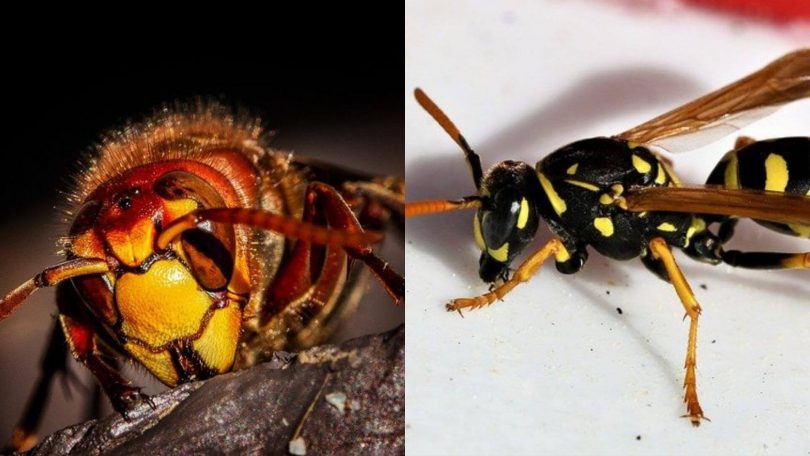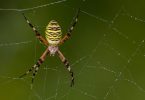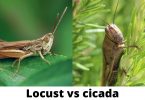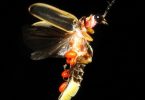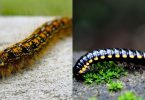In this article, we will be sharing the difference between the hornet and wasp. Although the focus is on the differences between the already mentioned insects, we will also look at the similarities that these insects share.
Hornet is a species of insect that belongs to the kingdom of animalia, the phylum of Arthropoda, in the class of insecta, under the order of Hymenoptera, belonging to the family vespidae, and the subfamily of vespinae.
Hornets are also species of social wasps, which is why it is important that we will be sharing the hornet and wasps. Wasps however, have the same scientific classifications as the hornet.
What is a hornet?
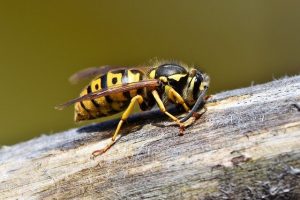
Hornets are different species of social wasps, because hornets as insects build a lot of communal nests by chewing and churning of wood to make it a very papery pulp.
For the hornet, each hornet’s nest has one queen in it, and it is the hornet queen that lays eggs which is finally attended to by the insects or hornet workers. However, it is genetically female, and cannot lay fertile eggs.
This species of insects called hornets build their nests in the open trees and the shrubs, but some of the species of hornets like the Vespa orientalis, more often than not build their nests in the other cavities or beneath the ground.
In the tropical areas, the hornet’s nests may actually last for about a year, however in areas that are temperate, the nest of the hornets die during the season of winter, while the single or lonely queens start to hibernate in the litter of leaf or the other materials that are insulative until the season of spring comes. More so, the male species of hornets do not have any stingers and are docile.
The hornets are usually considered to be pests being in places they are not wanted. They however, guard the sites of their nests very aggressively especially when they feel threatened or notice what seems to be a threat. In addition to that, the stings of the species of insects called hornets have been proven to be more harmful or dangerous than the sting of the buzzing bee who die from stinging people or insects, or other organisms generally.
Types or different species of hornets
There are different species of hornets, which could give us more insight into what we need to know about the hornet while we also see the points of difference between hornet and wasp.
These species of hornets include the following:
- Asian giant hornet
- Asian hornet or yellow-legged hornet or Asian predatory wasp
- Black hornet
- Black-bellied hornet
- Black shield wasp
- European hornet or Old World hornet or brown hornet
- Greater banded hornet
- Lesser banded hornet
- Oriental hornet
- Yellow hornet or Japanese yellow hornet or Japanese hornet
- Vespa luctuosa
Only a few of the hornets will be briefly explained and described in this section.
-
European hornet also known as the Vespa crabro
The European species of hornet is in appearance bigger than the Asian species of hornets in size. This species of hornet has the colour yellow on its head from the frontal appearance, and the colour red on the surface part. The Abdomen of the European species of hornet has black stripes with a yellow colour that seems pale. While the thorax and the legs of this species of hornets is usually black in colour, or even reddish brown.
-
Asian hornet (Vespa velutina)
The size of the Asian species of hornet is smaller than the size of the species of native hornets. This species of hornet has the colour orange on its head from the frontal appearance. However, the abdomen of the Asian species of hornet is almost totally dark in colour, and is aesthetically patterned with yellow stripes that are quite beautiful, and it has an orange or a yellow fourth segment that is very close to the base. While the thorax and the legs of this species of hornets is usually black in colour, or brown, and the leg is decorated with tips that are yellow in colour.
-
Hornet moth (Sesia apiformis)
This species of Hornet called moths share similar appearances or features with the Lunar species of hornet moth. Actually, these species of hornets are identified as clearwing moths. Clearwing moths is a group of species of insects or hornet mostly known for their attitude of mimicking the hymenoptera species of insects. (The hymenoptera species of insects is a group of insects which includes the following: the bees, the ants and the wasps).
The hornet moth species of hornets are mostly known for their very hairy body, or rather the body is covered in furs. The hornet moth species of hornets have two pairs of wings that are boldly outlined, they do not have defined waist but they have small eyes.
-
Asian Giant Hornet
Irrespective of the sex of hornet, the Asian giant species of hornet has a head with a very light shade of the orange colour, while the antennae of this species of hornet are brown in colour, and has the colour yellow with a blend of the colour orange at its base.
The eyes of the Asian giant hornet, as well as the ocelli of this species of hornet are usually dark brown and the black colour. The Asian giant species of hornet has a pronounced clypeus and also a large genae which makes the Asian giant species of hornet very different from the other species of hornet.
The mandible of an Asian giant species of hornet is orange in colour, and also contains a black tooth which the species uses when it has to dig. Also, the thorax of the Asian giant is dark in colour and has a shade of brown, it also has two grey wings that vary in span from thirty-five millimeter to seventy-six millimeter.
The Asian giant species of hornets have forelegs that are brighter than the hind and the mid legs while the base of the species has a darker base while the colour of the sixth segment of the species is yellow. The stinger of the Asian Giant Hornet is about six millimeter in length, and has in it very potent venom which could kill humans when there is a case of many hornets stinging almost immediately.
Life cycle of hornets
The different species of hornets have similar cycles of life. The life cycle of the hornet begins with the queen hornet. The queen hornet usually mates only during the season of autumn, and then survives the season of winter while crawling beneath the soil, or rotten wood, and barks of trees.
During the season of spring, the queen resurfaces and this time it emerges hunting for a place where it can build a nest. Once the queen hornet finds a nest, the queen hornet deposits her eggs which later develop into quite small larva within the period of or between five days to eight days of the deposit of the eggs in the nest.
After that phase, the hornet larvae however go through a period of five stages within the following twelve to fourteen days. The larva when it is grown forms for itself a thread of silk, with which it uses to cover the particular cell that they are in for the period of time.
So, within the period of about thirteen to fifteen days, the baby hornet is fully formed; this baby hornet carefully bites its way out of the thread of silk and the cell to further continue with its life cycle more actively. Soon about five to ten hornet workers emerge from the newbies or young hornets, then the hornet queen stops to actively hunt for food while the new hornet workers take control of the food hunting task.
What is a wasp?
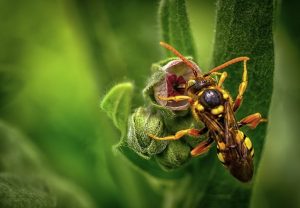
A wasp is a species of insect that has a waist that is narrow. The wasp like the Hornet species of insects belongs to the kingdom of animalia, the phylum of Arthropoda, in the class of insecta, under the order of Hymenoptera, belonging to the family vespidae, and the subfamily of vespinae.
The species of insect wasps naturally do not constitute any form of clade (clade refers to a group of organisms who are believed to include or are made up of all their evolutionary descendants, and are of a common ancestor), nor do they involve any natural group with any ancestor (not even one), because wasps share the same ancestor with species of bees as well as different species of ants.
Life cycle of a wasp
The cycle of life of a wasp colony usually begins in the early seasons of spring, under the reign of care of a new queen of the species of wasp. However, the end of the new cycle of life is usually in the season of winter with the death of the queen of the species of wasp colony.
The life cycle is the same for any species of wasp colony system. There is Queen of the wasp who searches for a nest where it lays one egg, then there is the female sterile wasp worker, and male counter parts of the species of wasps.
Different types or species of wasp
The species of wasps are basically divided into their conditions of existence. There are wasps that live communally, and are called social wasps because they associate with other species of wasps and move in a swarm. While there are the other species of wasps that are known as the lone or solitary wasps.
A few species of wasps will be listed here, and some will be briefly explained.
- Cicada Killers
- Yellow jacket wasps
- Cuckoo wasp
- Jewel wasp
- Gall wasp
- Paper wasp
As stated earlier, a few of these species of wasps will be explained.
-
Cuckoo Wasp
The Cuckoo species of wasps are very smart species of wasp. The colour of the cuckoo species of wasp is the metallic-green or the metallic -blue colour. This species of wasp has intricate sculptures on its exoskeleton. Also, the cuckoo species of wasps often lay their eggs in the wasp nests of the solitary bees or the solitary wasps.
More so, the bodies of the species of wasp are clothed in quite long, thick hair that has very contrasting colours; usually the black and red colours. The female cuckoo species of wasps do not have any wings and they have or rather take after the resemblance of ants.
-
Gall wasps
The gall species of wasps has a very distinctive shape of the body, as well as the wasp waist. The propodeum or the first abdominal tergum of the gall species of wasp is attached with the gall wasp’s thorax, then its second abdominal segment creates the petiole which can be likened to a shaft.
However, the petiole of the gall species of wasp is mostly connected with the part called gaster. This part called the gaster is a very functional or active part of the abdomen in the apocritan wasps, which begins properly with the third abdominal segment. Then, the petiole and the active or functional abdomen (that gaster) create the metasoma, and the mesosoma is made up of the propodeum and the thorax.
The gall species of wasp has antennae that are quite straight, and also has segments of about two to three partitions. In varieties of different galls, the dorsal part of the mesosoma is a bit banded by longitude, While the wings of the gall species of wasp are very simple and well structured. The female’s egg-depositing the ovipositor of the female gall which is used for the deposition of eggs which is seen to be protruding around the tip of the part called the metasoma.
-
Jewel species of wasps
The jewel species of wasp is also known as the emerald cockroach of wasps. So, the colour of the body of the jewel species of wasp is a metallic blue colour blended with shades of green, and the thighs of the second, and the third pairs of legs of the emerald cockroach is red in colour.
The female emerald cockroach species of wasp is about twenty-two millimeters long, while the male jewel species of wasp is smaller in size, shorter in length, and does not have any stinger at all. When evolving from a host that is super parasitized, the male emerald cockroach is basically beneath the half of the female jewel wasp in size.
This species of wasps goes through four larval stages, in which the first younger larvae may usually be seen to be external hemolymph-feeders on the paralyzed leg of a roach, while the final instar internally feeds.
More so, the pupation produced by the emerald cockroach species of the wasp is chocolate in colour, it is thick, and has a cocoon that is spindle in shape, which is usually found inside the burrow of a dead cockroach.
Similarities between the species of hornets and the species of wasps
The reason we carefully outlined the different species of hornets, and the different species of wasps is to enable us to easily identify the similarities. We will briefly identify the similarities between the species of hornets and the species of wasp.
Some of these similarities include the following:
That the species of hornets, and the species of wasps are all insects. And the various species of hornet and species of wasp share the same ancestral origin.
That the various species of hornets and the various species of wasp belong to the same scientific classification, which includes: that they belong to the kingdom of animalia, the phylum of Arthropoda, in the class of insecta, under the order of Hymenoptera, belonging to the family vespidae, and the subfamily of vespinae.
Finally, based on the similarities in this section, the hornets are mostly social wasps, so it is safe to say that the wasp builds the umbrella under which the different species of hornets find their existence, or exist in reality.
Difference between the hornet and species of wasp
This is our main focus of this article “difference between hornet and wasp”. From the entire details of the different species of hornets, and the different species of wasps, it is very clear that these different species of insects are not as different as the differences in their names suggest.
These species of insects share a huge number of similarities that out numbers or outnumbered the possible differences they share.
The only differences between the hornet and wasp, and the different species include the following:
That the different species of wasps are mostly smaller in size than the size of the different species of hornets. More so, another difference between the hornet and wasp is that generally, all the species of hornets are social wasps, while all the species of the wasps are divided into the solitary wasps and the social wasps. Apparently, the species of hornet are under the family bracket of the wasp by the virtue of being a social wasp.

